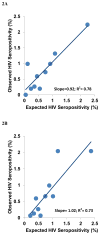Validation of an abbreviated version of the Denver HIV risk score for prediction of HIV infection in an urban ED
- PMID: 24768338
- PMCID: PMC4112596
- DOI: 10.1016/j.ajem.2014.02.043
Validation of an abbreviated version of the Denver HIV risk score for prediction of HIV infection in an urban ED
Abstract
Objective: We sought to evaluate the performance of an abbreviated version of the Denver HIV Risk Score in 2 urban emergency departments (ED) with known high undiagnosed HIV prevalence.
Methods: We performed a secondary analysis of data collected prospectively between November 2005 and December 2009 as part of an ED-based nontargeted rapid HIV testing program from 2 sites. Demographics; HIV testing history; injection drug use; and select high-risk sexual behaviors, including men who have sex with men, were collected by standardized interview. Information regarding receptive anal intercourse and vaginal intercourse was either not collected or collected inconsistently and was thus omitted from the model to create its abbreviated version.
Results: The study cohort included 15184 patients with 114 (0.75%) newly diagnosed with HIV infection. HIV prevalence was 0.41% (95% confidence interval [CI], 0.21%-0.71%) for those with a score less than 20, 0.29% (95% CI, 0.14%-0.52%) for those with a score of 20 to 29, 0.65% (95% CI, 0.48%-0.87%) for those with a score of 30 to 39, 2.38% (95% CI, 1.68%-3.28%) for those with a score of 40 to 49, and 4.57% (95% CI, 2.09%-8.67%) for those with a score of 50 or higher. External validation resulted in good discrimination (area under the receiver operating characteristic curve, 0.75; 95% CI, 0.71-0.79). The calibration regression slope was 0.92 and its R(2) was 0.78.
Conclusions: An abbreviated version of the Denver HIV Risk Score had comparable performance to that reported previously, offering a promising alternative strategy for HIV screening in the ED where limited sexual risk behavior information may be obtainable.
Copyright © 2014 Elsevier Inc. All rights reserved.
Conflict of interest statement
Figures






Comment in
-
Validating a human immunodeficiency virus risk score.Am J Emerg Med. 2014 Dec;32(12):1535-6. doi: 10.1016/j.ajem.2014.09.008. Epub 2014 Sep 18. Am J Emerg Med. 2014. PMID: 25284483 No abstract available.
-
In reply to: "Validating an HIV risk score".Am J Emerg Med. 2014 Dec;32(12):1534-5. doi: 10.1016/j.ajem.2014.09.016. Epub 2014 Sep 19. Am J Emerg Med. 2014. PMID: 25440227 Free PMC article. No abstract available.
References
-
- Centers for Disease Control and Prevention. Revised recommendations for HIV counseling, testing, and referral. MMWR Recomm Rep. 2001;50:1–62. - PubMed
-
- Centers for Disease Control and Prevention. Recommendations for HIV testing services for inpatients and outpatients in acute-care hospital settings. MMWR Recomm Rep. 1993;42:1–10. - PubMed
-
- Branson B, Handsfield H, Lampe M, et al. Revised recommendations for HIV testing of adults, adolescents, and pregnant women in health-care settings. MMWR Recomm Rep. 2006;55:1–17. - PubMed
-
- Rothman R, Hsieh Y-H, Harvey L, et al. 2009 US Emergency Department HIV Testing Practices. Ann Emerg Med. 2011;58:S3–S9. e4. - PubMed
Publication types
MeSH terms
Grants and funding
LinkOut - more resources
Full Text Sources
Other Literature Sources
Medical

